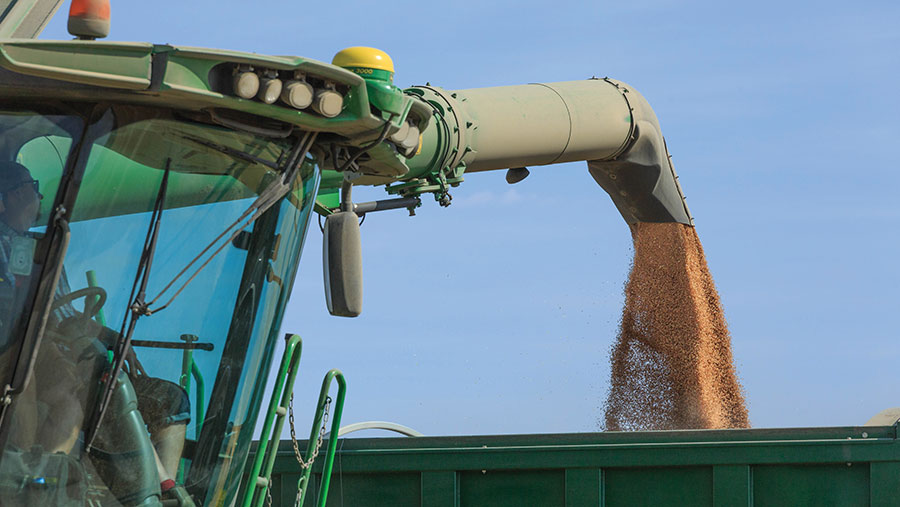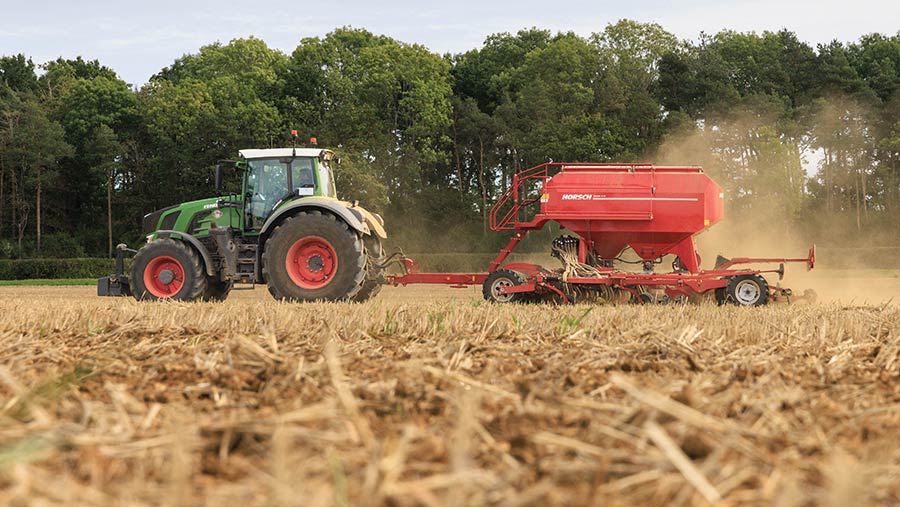Tips on growing profitable second wheats
 © Tim Scrivener
© Tim Scrivener Farmers on decent wheat-growing land should consider adding second wheats to the rotation, as few other crops are as profitable.
Although margins are tighter due to higher input costs – notably nitrogen – and grain prices dropping below £200/t, with strong domestic demand for feed and milling wheat, plus export potential closer to ports, it remains the primary cash crop for many.
See also: Advice on septoria spread as wheat T1 fungicide timing nears
“Wheat is the highest-margin crop in our toolbox, and many of our clients look for about 60% of their rotation in wheat,” says Essex-based farming consultant Lexi Taylor, of Ceres Rural.
“That includes second wheats where land is capable of supporting a good crop.”
A further push towards second wheats is coming where growers have stopped growing oilseed rape due to establishment risks, notably cabbage stem flea beetle.
This can then raise questions about winter barley’s position in the rotation, a crop often grown to provide early entry for oilseed rape.
Equally, where beans replace oilseed rape, growers want to extend the gap between bean crops to manage pest and disease risks, which can make second wheats useful.
Storage logistics are less of an issue than with alternative crops, existing machinery can be used, and agronomic practices are well understood, says Lexi.
“By increasing the percentage of wheat in the rotation, as long as you can manage take-all, generally you can derisk the enterprise.”

© Tim Scrivener
Tackling risks
Lexi acknowledges yield can drop between first and second wheats, but this does vary. Analysis of 65 Ceres client farms shows an average 12% reduction. However, some farms do maintain yields, while others experience a more dramatic fall.
Yield reductions can be due to many factors, and Lexi, along with Ceres Rural’s Oxford-based adviser, Edward Thompson, highlights five main risks to manage.
1. Grassweeds
Depending on crop maturity and harvest date, there can be a relatively narrow window for weed control in the autumn when growing consecutive wheats, and a reliance on similar chemistry.
Ideally, second wheats should, therefore, be planted into fields without a high grassweed burden.
Where possible, delayed drilling can help grassweed (and take-all) control in the autumn.
If spring wheat is being grown, then sowing early (in early March, for example) when conditions allow can also assist grassweed control through a bigger, better-established spring crop, Edward suggests.
In some cases, spring wheat varieties may be sown towards the end of the autumn drilling window (early November, for example).
2. Take-all
Take-all is estimated to affect half of UK arable land, and once in the soil, it is hard to eliminate, so the focus is on managing risks using cultural and chemical controls.
3. Weather/seed-beds
A good, well-consolidated seed-bed is key to successful second wheats establishment, giving crops the best chance of developing strong roots before winter, thereby increasing resilience to the weather, weeds, pests and diseases, says Lexi.
While later drilling can help manage grassweeds and take-all, seed-bed preparation and establishment may be more challenging in colder, wetter soils, so risks must be evaluated on a field-by-field basis.
4. Trash management
Large straw residues between first and second wheats can be challenging to drill into and ensure good seed-to-soil contact.
Therefore, it must be managed carefully, either at harvest or with post-harvest cultivations.
5. Volunteers
Volunteers from previous crops can increase disease pressure (brown rust, eyespot and septoria, for example).
They can also provide a green bridge for take-all or barley yellow dwarf virus-carrying aphids (bird-cherry oat and grain aphids), to transmit disease into subsequent crops, so they should be controlled early to allow a sufficient gap before drilling.
Variety choice
Selecting varieties that perform well as second wheats is another important risk management tool, and the AHDB Recommended List (RL) is a useful starting point, according to plant breeder DSV’s Sarah Hawthorne.
Alongside second wheat yield, she encourages growers to consider the speed of development of varieties drilled in October and November to growth stage 31. “It’s important in the autumn and spring, as well as growing a variety with a prostrate growth habit.”
Eyespot resistance is a particularly useful trait, as is strong root development and good resistance to brown rust, septoria and yellow rust, she adds.
Biomass is often lower in second wheats due to later drilling, so selecting a variety that puts down roots quickly, with a high tillering capacity, can benefit yield, crop competitiveness and resilience throughout the growing season.
The Group 4 feed wheat Champion from DSV has such characteristics, inherited from parent varieties Brompton, Denman and Oakley, she says.
“Champion was the highest-yielding variety to be grown in a second wheat position last year and is the second highest-yielding on the RL this year, proving its ongoing yield performance in this difficult situation.”
Edward says other popular second wheat varieties in his region include Extase, Zyatt and Graham.
Budget combinable crop gross margins for harvest 2024 |
||||||||||||
| Feed winter wheat | Milling winter wheat | Winter barley | Winter oilseed rape | Winter beans | Milling winter oats | Spring beans | Spring malting barley | Spring wheat | Spring oats | Second feed wheat | Second milling wheat | |
| Yield (t/ha) | 8.5 | 8.5 | 8 | 3 | 3.5 | 6.2 | 3.5 | 6.2 | 6 | 4.8 | 7.5 | 7.5 |
| Price (£/t) | 180 | 180 | 150 | 350 | 230 | 160 | 230 | 150 | 180 | 150 | 180 | 180 |
| Output (£/ha) | 1,581 | 1,870 | 1,260 | 1,113 | 805 | 1,072 | 805 | 1,197 | 1,080 | 722 | 1,395 | 1,650 |
| Variable costs (£/ha) | 604 | 752 | 540 | 707 | 336 | 344 | 372 | 408 | 399 | 255 | 667 | 776 |
| Gross margin (£/ha) | 977 | 1,118 | 720 | 406 | 469 | 728 | 433 | 789 | 681 | 477 | 728 | 874 |
|
*Based on nitrogen price of £1.014/kg. Second wheat seed cost includes Latitude. Source: Ceres Rural |
||||||||||||

